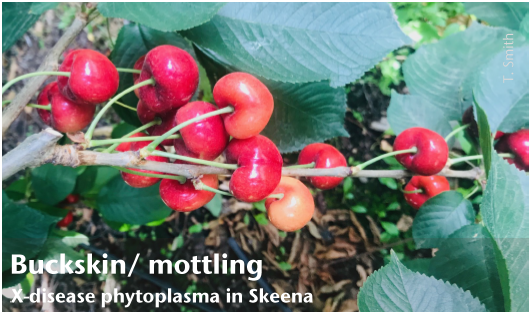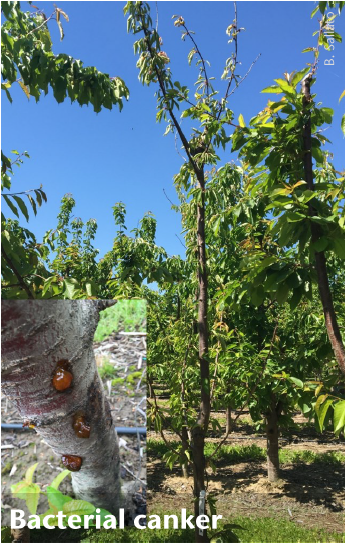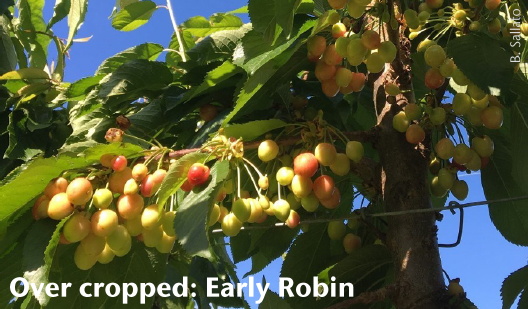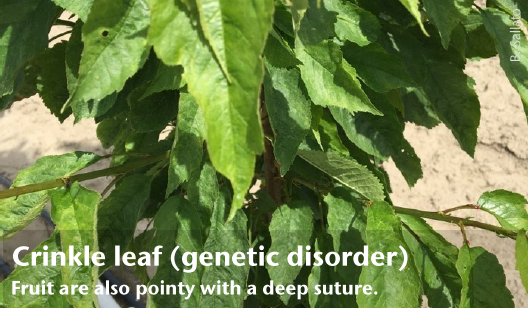X Phytoplasma and Little Cherry Virus Scouting and Sampling Guide
Compiled and edited by
Tianna DuPont, WSU Extension; Scott Harper, WSU Plant Pathology; Bernardita Sallato, WSU Extension; Ashley Thompson, OSU Extension
Edition 1. Copyright © 2020 Washington State University.
First printing June 2020
Funded in part by the Washington State Tree Fruit Research Commission
Thank you to advisory group Garret Bishop, Teoh Smith, Hannah Walters, Dale Goldy, Craig Harris, Phil Doornink, Denny Hayden, Alfredo Reyes.
Thank you to reviewers Karen Lewis, Gwen Hoheisel, Ines Hanrahan, Jenny Bolivar, Tobin Northfield, Jay Pscheidt.
Download
Table of Contents
(these can link to sections on the page)
Introduction
Little cherry virus 1 (LChV1), Little cherry virus 2 (LChV2) and X-disease phytoplasma cause small cherry symptoms often described as ‘Little Cherry’ or ‘X-disease.’ Diseased trees produce cherries of small size and poor color and flavor making the fruit unmarketable. X disease is at epidemic levels in the Columbia River basin, with high incidence in Yakima, Benton, and Franklin counties, and present in Oregon, The Dalles area. Timely scouting and aggressive tree removal are essential to reduce the spread of the disease. Infected trees spread the pathogen to neighboring trees by insect vectors or via root-grafting from tree-to-tree. Infected trees can not be cured and MUST be removed entirely. This guide is designed to provide information on symptoms, scouting and sampling to encourage effective tree removal and management.
Symptoms


Progression of Symptoms
Early infection (Year 1), small fruit may be restricted to one branch, or cluster, fruit color may develop normally, or individual pale fruit may be observed.
Middle infection (Years 2-3), small fruit observed on multiple or all limbs, and poor color development is pronounced.
Terminal infection (4+ years), generally reduced fruit yield, and with X-disease phytoplasma infection dieback of limbs.



Symptoms Checklist
Symptoms Checklist
- Cherries smaller than normal?
- Cherries round or misshapen/pointed?
- Color too pale?
- Skin mottling or blotching (buckskin)?
- Cut into the cherry
- Is the pulp color correct?
- Is the seed small or misshapen?
- Taste the cherry
- Is it bitter?
- Tasteless?
If you have two or more of these symptoms, please check for LCV and X-disease phytoplasma.





In peaches, plums, and nectarines
X-disease symptoms are typically yellowed curled leaves and shot hole as well as small deformed fruit.
Leaf yellowing symptoms on infected peaches and nectarines begin to appear about 2 months prior to harvest, and get progressively worse, with shotholes appearing as the season progresses.

Disorders which cause similar symptoms
Water/salinity stress, and over-cropping symptoms generally throughout tree vs one branch.





Scouting


Trees with symptoms:
Sample from symptomatic limbs. Samples only needed in non-confirmed blocks. With many symptomatic trees consider sending samples from a portion of suspect trees.

Trees with no symptoms:
Sample from each leader.

Example Stemilt
Hannah Walters’ group works in teams with a lead scout. Scouts GPS tag and flag symptomatic trees. They send in a portion of symptomatic trees for laboratory confirmation to check accuracy for new scouts. For example, if they flag 20 trees, they send in samples for 10. If all 10 come back positive they remove all 20 flagged trees. For removal they use either the herbicide painted cut stump or “notch” drill and inject herbicide method. Walters says “We are finding X scattered randomly in blocks vs hot spots so it is important to look at all trees in a block.” They consider age of trees and economics of block when deciding whether to remove a whole block.
Example GS Long
Garrett Bishop and his group focus on spots identified by growers or fieldmen and then randomly scout at least 25% of entire block. Using quads in low gear (about 3 miles per hour) they look at the whole tree when scouting and sampling, especially concentrating on both small limbs off the main scaffold and the lower section of the tree that often seem to be symptomatic. The growers GS Long scout for remove trees using either the cut stump or notch (drill) herbicide method.
Example Goldy
Dale Goldy’s scouts walk the block in the week before harvest. They find there are too many false negatives when scouting is done earlier. They look at every tree. “We want to find new outbreaks so we have to look at every tree.” They remove symptomatic/ positive trees by first drilling and applying herbicide in holes and then cutting out dead trees. They find that timing for herbicide application is important. Trees treated in August die quickly. If more than 20% of the block is affected they remove the entire block.
Example Zirkle
Teah Smith and her crew scout in teams. Teams scout with one person on each side of the tree on four-wheelers in low gear looking at every tree. They flag trees with flagging tape that is labeled numerically and alphabetically (eg. Sample 22 is positive so the 8 trees around it are labeled as 22A, 22B, 22C, etc). They remove positive trees and sample from adjoining trees. If adjoining trees are positive, they are removed, and the next tree out sampled until trees are all negative. They remove trees by pulling trees, removing as many roots as possible. Generally, if more than 20-30% of the block is infected/ has been removed from LCD, the entire block is removed.
Keep tissue moist and cool. Old or dried tissue is more likely to have false negatives. Best to send samples early in the week.

To submit a sample look at updated list of labs
Remove infected trees

REMOVE
INFECTED
TREES!
Contacts
Tianna Dupont, WSU Extension (509) 293-8758 tianna.dupont@wsu.edu
Bernardita Sallato, WSU Extension (509) 439-8542 b.sallato@wsu.edu
Ashley Thomson, OSU Extension (541) 296-5494 Ashley.Thompson@oregonstate.edu
Karen Lewis, WSU Extension (509) 760-2263 kmlewis@wsu.edu
Thank you to partners:
Washington State Tree Fruit Research Commission
G.S. Long












